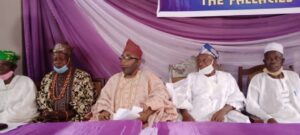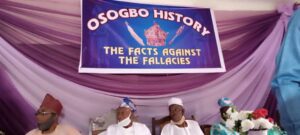Three households, Sogbo, Lahanmi, and Matanmi held a conference to clarify the book written by Aderemi Oduola on the history of Osogbo, the Osun State capital.
According to the press statement made available to AMILOADED, three representatives from each household to clarify the history of the town as they alleged fallacies in the book written by Aderemi Oduola.
The speakers include Omo-Oba Ganiyu Olaniyan from Sogbo household, Aderemi Atoyebi from Matanmi household, and Ganiyu Olasunkanmi Salahu from Lahanmi household
The conference was titled, “Osogbo History: The Facts Against The Fallacies Text Of A Press Conference Hosted By The Sogbo, Lahanmi And Matanmi”.
It read, It is imperative that issues of the cultural heritage and history of Osogbo land, particularly as it concerns ascendancy to the traditional stool of the Ataoja and the Royal families that have kingship rights, be factual and truthful. This is to ensure that the present young generation and those yet unborn can learn the true history of their fatherland.
This publication is therefore to set records straight and document certain parts of the Osogbo history on which distortion attempts have been made, of particular example which is the book written by Aderemi Oduola(Oju Pon Koko Ma Fo), which distorted the true history of Osogbo and attempted to confuse the unsuspecting public.
For the records, there are presently three (3) traditionally recognized bodies saddled with the responsibility of guarding the history of Osogbo land. These are:
1. Osogbo Cultural Heritage Council
2. Department of Osogbo Affairs
3. Ataoja-In-Council
There are certain books on Osogbo hisyory, endorsed by these bodies. These are:
1. Osogbo Oroki Asala landmark
2. The history of Osogbo by Bamiro Aofolaju
3. The siege of our time by Olusola Ajayi, supervised by Department of Osogbo Affairs.
It is on record that when the books ‘The Comprehensive History of Osogbo’ written by Justice Falade from Abodun Compound and ‘Osogbo, the melting pot’ written by Pa. Michael Akinlade from Balogun Agoro compound were written, these committees publicly the claims made in these two books and made a publication to that effect in Nigerian Tribune newspaper of March 26, 2001. The publication stated clearly that the families of the authors only arrived in Osogbo during the reign of the third Ataoja and cannot therefore tell the full history of Osogbo land.
ATAOJA AJIBOLA AINA SEREBU
Owa Lajomo, son of Oosanike (who hailed from Ora Igbomina), was the first born of Owa Laege. Owa Lajomo became King in Ipole- Ijesha. His children, according to indisputable records were Olude, Aderounmu, Weida, Arosunseya, Kolorosi ( who later got married to a man from the Iyalode family). Lajomo was never King in Osogbo as he was the Seventh Owa in Ipole- Ijesha.
The children of Owa Laege were Lajomo, Larooye and Sogbodede. Tekulu ( who was the daughter of Alaafin Ajiboyede of Oyo kingdom) was the mother of Larooye and Sogbodede. Larooye became the eighth Owa of Ipole- Ijesha after his brother, Lajomo.
Adeduhan hailed from Iresa-Apa, close to Ogbomoso. He was the son of Talo (mother) and Agbaoni (father) of the Igbaku family. The same Talo was the mother of Ataoja Ajibola Aina Serebu and Oyelekan. Their father was Ataoja Sogbodede and it is on record that Talo birthed children for two different husbands – Agbaoni (of Irese- Apa) and Ataoja Sogbodede, having been married to both men at different times.
The children of Adeduhan, who were by lineage, from Iresa- Apaz, were Loode and Idowu. They had small tribal marks which clearly distinguished them from the lineage of Ijesha to which the second of husband of their mother, Ataoja Sogbodede, belonged.
LAYIOKUN
The original name of this family was Adeyinka. At the time Ataoja Ajibola Aina Serebu brought his sibling back to Osogbo from Iresa- Apa after the death of their mother, he left him in the care of his relatives in front of the Ataoja place, with Adeyinka.
As the children of Adeyinka grew older, they got the permission of their father to each go out of the family house to establish their own families. Sangosowo, one of his sons, went to settle in the house of Oluawo Oba Makanjuola. Adetifewa and Olokungboye followed him to his new settlement. It must be noted that their new settlement was not in Ita Olokan at all. Ajibola went to settle at Oke Popo in the house of Ajibola, while Akegun also settled around Orita Elelede. Layiokun also attempted to leave his father’s house but he was not given the permission. He later inherited their father’s home with Adeyinka died.
It was Ataoja Ajibola Aina Serebu who gave birth to Gboyemu and Obodegbewa. The descendants of Lahanmi that have asserted that they are not children of Ojo Laalele and that the recent attempt by Pa. Oduola to tell the story of their lineage was not based on any thorough research, as a lot of the claims in his book ‘Oju Pon Koko Ma Fo’ were against the true records of Osogbo history.
After the death of Ataoja Ajibola Aina Serebu Abogbe, child of Ataoja Larooye became Regent. Obodegbewa was the the heiress to Ataoja Aina Serebu and she was married to Lahanmi who was the son of Alaafin Abiodun Adegoolu who was King in Oyo kingdom from 1770 – 1789. Ojo Laalele was the son Ayoka had birthed in Kuta before getting narried to Lahanmi. Ayoka birthed both Ojo Laalele and Ataoja Ogunike Durosinmi Fabode, but for different fathers.
It was Ataoja Fabode who brought Ojo Laalele into Osogbo when he became King, being his half brother. Lahanmi had three wives and these were Obodegbewa, Ayoka and Fafunke.
Abogbe who gave birth to Matanmi, was the only child of Ataoja Larooye. Agbogbe gave birth to Ataoja Oladele Oladeobi (Matanmi) and it was this Ataoja (Matanmi) who became the first Baale of Osogbo and was placed in Oke Odo (now known as Oke Baale). It was after this that Ataoja Aina Serubu gave him the permission to receive guests and sell land to migrants who come into Osogbo to settle within his jurisprudence. This shows the kind of relationship that existed between both men.
On the Obaship of Ataoja Samuel Adeleye Adenle, there was never a crisis as serious as the ine described by Pa. Oduola in his book. At the time under reference, the District Officer (D.O) who was covering this area was reporting to Ibadan. When the royal families wanted to go to Ibadan to see the white man who was then head of the Western region and to Olubadan, Oba Abass, representatives were selected from the concerned families and these were the Gboyemu family and the family of Oluawo Oba. Ajibola Babarinde led this delegation. The delegation from the Gboyemu family included Shittu Oyelami and Raji Oyetola. The delegation from the Oluawo Oba family included Fayoyinwa, Osadare and Adeabgo. There was no person from the Adeduhan family in this delegation
Pa. Oduola also went on to claim that the Adeduhan lineage contested the Ataoja stool at one time. This is false. If they did, at what time was this contest? With whom did they contest the stool? What was the name of the candidate from their family? Ibiloye is not a member of the Adeduhan family and therefore cannot be present at events such as this. When Pa. Idowu who was from the Adeduhan family died, his corpse was placed on a mortar and when his kin, who were descendants of Adeduhan came, they instructed that the corpse be brought down as is is only Ijesha people who put their corpses on mortar.
Immediately Pa. Ajibola Babarinde said this, all of the persons who followed him there turned their backs. These included Raji Oyetola, Sadiku Babarinde, Shittu Oyelami, Jimoh Oyedijo and Oyeniyi Oyedijo.
BABA ISALE TITLE
Ataoja Kolawole selected two persons from his father’s family and another person from hid great grandmother’s family. The ones from his father’s family were Ajibola Babarinde from the Gboyemu family and Adedotun from Oluawo Oba family. He also picked Idowu Adeduhan and made them Baba Isale. This showed that he did not forget his kins from his great grandmother’s family, since it was Ataoja Aina Serebu that brought Adeduhan to Osogbo. Knowing that he did not belong to the Royal lineage, but was only honoured to the Baba Isale, Pa. Idowu Adeduhan could not ever join in Olomo Oba meetings or any meeting that had to do with the Sogbodede family.
Idowu, wanting to not be the only person from his family who will be present in the King’s Court, pleaded with Ataoja Kolawole to pick one more person from his own father’s family, who was the son of Oyero, from the Lagada family. The Layiokun family vehemently opposed this move; one of the representatives of the Layiokun family at the time was Oyeyemi, the grandfather of Alh. Ganiyu Akala. After much deliberations and arguments, they eventually consented to the selection of Ibiloye.
Ataoja Ajibola Aina Serubu was the first Ataoja who was favorably disposed to welcoming migrants into Osogbo. He was the first Ataoja who gave land to migrants for farming and for settlement. There are a lot of families today in Osogbo, who were welcomed and allowed to settle in the town, by this same Ataoja. He was also the first King to install chiefs that could be referred to as Kingmakers (Iwarefa). This is in practice in Osogbo till date.
There was no point in history of Osogbo that the people of Gbaemu family or their descendants were barred from becoming Kings in Osogbo (as falsely claimed in Pa. Oduola’s book). There was also no time that anyone found Ataoja Ajibola Aina Serebu or any of his lineage guilty of any wrongdoing in the running of Osogbo.
Ademola Enquiry stated that if the children of Adeduhan wants anything in Osogbo, they should seek information from the true descendants of Sogbo, having grouped them under Lajomo royal lineage. According to the Ademola Enquiry, the Adeduhan lineage could not be created a single lineage since their father, Adeduhan did not establish one by becoming an Ataoja himselfm
We recommend the following books to anyone who wants information on the true history of Osogbo land
1. The History of Owa Obokun
2. The Genesis of Yoruba Race
3. Commission on Chieftancy Declaration review of Oyo state, 18th November, 1976, page 132.
See photos below:



Leave a Reply